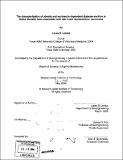The characterization of obesity and noninsulin dependent diabetes mellitus in Swiss Webster mice associated with late-onset hepatocellular carcinoma
Author(s)
Lemke, Laura B. (Laura Beth)
DownloadFull printable version (12.76Mb)
Other Contributors
Massachusetts Institute of Technology. Biological Engineering Division.
Advisor
James G. Fox.
Terms of use
Metadata
Show full item recordAbstract
Despite increased awareness of the obesity epidemic and a higher incidence of the metabolic syndrome in humans, the incidence of obesity and its comorbidities-most notably, type II diabetes (T2D) and cardiovascular disease (CVD)-continues to increase. Although numerous animal models are available to study the molecular pathways, genetics and therapeutic/prevention strategies for T2D, no model completely recapitulates T2D or it's comorbidities in humans. Therefore, novel animal models represent valuable research tools in understanding T2D. To develop a novel mouse model of T2D, I characterized an outbred mouse discovered at MIT that displayed clinical signs of diabetes. Prevalence of glucosuria in the Swiss Webster colony reached 60% (n=70) in males 8 weeks to 6 months of age. Despite severe obesity in some females, no females were diabetic. Pathologic findings in affected males included cachexia, dilated gastrointestinal tracts with poor muscular tone, pancreatic islet degeneration and atrophy with compensatory metaplasia and/or neogenesis, bacterial pyelonephritis, membranous glomerulopathy, and late-onset hepatic tumors with macrosteatosis, microsteatosis and hydropic change in aged males. Serum insulin correlated with blood glucose in a nonlinear pattern suggestive of islet exhaustion. Circulating leptin levels showed a weak inverse correlation with glucose. Diabetic males were bred with obese colony females to produce 20 male and 20 female offspring. Prevalence of diabetes in male offspring was 80% (16/20) with a median age of onset of 18 weeks. In contrast, no diabetic females were identified, despite being significantly more obese than males. Male predominance is likewise a feature of T2D in humans. (cont.) To our knowledge, this is the first documentation of hepatocellular carcinoma and islet metaplasia and/or neogenesis in a spontaneous outbred mouse model of T2D. The SW availability and histolopathologic features represent a promising new model for the study of T2D. Further studies are required for complete molecular and genetic characterization of the diabetic SW mouse. These studies are outlined in this thesis.
Description
Thesis (S.M.)--Massachusetts Institute of Technology, Biological Engineering Division, June 2008. "May 2008." Includes bibliographical references.
Date issued
2008Department
Massachusetts Institute of Technology. Department of Biological EngineeringPublisher
Massachusetts Institute of Technology
Keywords
Biological Engineering Division.